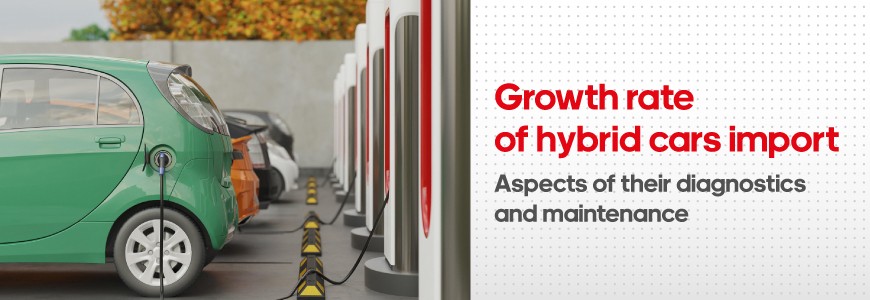
Originally, hybrid vehicles were engineered as a springboard for developing of completely electric vehicles. The more plug-in hybrid vehicles appeared on the market the more popularity they got because they could provide the significant fuel economy in the city - compared to the vehicles with internal combustion engine. Besides, hybrid vehicles have a positive effect on the ecological safety of cities. That’s the reason why many countries offer financial incentives to purchasing this type of vehicles. This fact encouraged many auto manufacturers to develop the hybrid versions of the existing models, such as Mitsubishi Outlander PHEV, Ford Fusion Energi, Hyundai Ioniq, Volvo V60, Audi E-tron, Chrysler Pacifica, Range Rover PHEV etc.

Expansion of model range of hybrid vehicles and alternative fuel vehicles in the world
Hybrid car operation is as much demanding as the operation of a car with IC engine. Yet, there’s a trouble that all owners face in the end - lose of capacity of high voltage battery. High voltage battery - the most loaded element of hybrid vehicle because it constantly discharges and charges. Thus, it’s a high voltage battery that causes troubles the most. With age, the battery capacity gets lower, the cells disrupt, moreover, the disruption is not uniform. The environment critical temperature points (extreme heat or severe cold) may shorten its life span. The car manufacturers set up the battery service life as long as a car service life. On average, it’s around 8-10 years. The proper car operation and its timely maintenance prolong battery service life up to 15 years.
The construction defect of all high voltage batteries is a cascade-effect, when the disruption of one cell leads to the disruption of adjacent cells and so on. The main failure reason - overheating. All the batteries have cooling system. If a car owner doesn’t take care of it, the early battery failure is inevitable.
When a car owner faces the significant reduction of a high voltage battery capacity or with the hybrid system error on the control panel, caused in 90% cases by a battery failure, as for other units, three options can be offered: either replacement for a new battery, replacement for a used battery or its reconditioning.

The replacement for a new battery is quite expensive while there’s a big offer of the used batteries at pretty low price. At the same time, the purchase of a used battery brings a risk because no one can provide the exact information on the condition of its modules. That’s why the reconditioning of high voltage batteries is currently getting more popular.
Diagnostics and reconditioning of high voltage battery
The testing of the condition of battery modules with car integral diagnostic tools is not possible. Now, the only way to check the condition of each module is a dismounting of battery from a car, its partial disassembling and testing with a special tester.

High voltage battery ready for diagnostics
In the product range of MSG Equipment, it’s a tester MS800. It can check the capacity of each module of high voltage nickel-metal hydride battery (Ni-Mh, NiMh). The tester can simultaneously check up to 36 modules completely automatically, and within 24 hours. The tester has all the required safety features: reverse polarity, short circuit, overheat protection. Thus, while a battery is tested, the servicemen prepare the next battery for diagnostics or recondition already checked battery.

Tester MS800 during battery testing
The tester MS800 operates off 220V mains power supply at the maximum load of 12A. It has compact dimensions, user-friendly operation control on the touch screen, and software update availability.
What are the financial benefits for client from battery reconditioning?
The experience of the first Ukrainian special purpose center on the service of electric car and hybrid - Master Service Electro - shows that the reconditioning of high voltage battery is pretty beneficial for the clients. For example, let’s study the reconditioning of the battery of Lexus RX450h 2013. Totally the client paid $750 having 10 failed modules from 30. The new battery would cost around $7500, the used one - from $1500 up to $3000. One more example, the reconditioning of the battery of Toyota Prius 30 2012. Totally the client paid $250 having 2 failed modules from 28. In this case, the new battery would cost around $2800, the used one - from $850 up to $1500.
Summary
Starting a service on the reconditioning of hybrid car batteries guaranties your repair shop a high demand for many years ahead. You know, the global car industry tends to the development of both hybrid and electric cars. At present time, the share of sold hybrid and electric cars comes to more than 24% of all sold new cars in Europe. And the sales are massively growing in the last few years.

Growth rates of sales of the most popular hybrid car models in Europe (in thousands)
The availability of the tester MS800 in repair shop makes it possible to provide the reconditioning of the hybrid car batteries, as well as sell the used batteries that are already tested and 100% in order. It’s a significant competitive advantage at the market of used spare parts. In case the used battery is not in order, you can use its good modules for the reconditioning of other batteries. Thus, the operation of tester MS800 will be always rewarding.
For more details on the tester MS800, contact our sales managers on the phone +38 (067) 434 45 33 (WhatsApp, Viber, Telegram) or complete the contact form.



COMMENTS